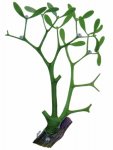mistletoe
Viscum album L.
Botanical characteristics. Belongs to the family of belts. An evergreen semi-parasitic shrub plant penetrating the cortex and into the wood of the host tree with the help of sucking roots. Stems dense, woody, abundantly branching, with swellings at the nodes. Leaves opposite, naked, sitting, leathery, dark green. Blossoms in March-April. Unattractive greenish-yellow flowers are gathered in heaps. Fruit is a white fleshy berry, ripens in August-September.
Spread. Usually found in the southern and south-western regions of the European part of the country and in the Caucasus. Prefers as the owner of fruit and wild deciduous trees, less often - coniferous trees.
Used parts of the plant.
Leaves, young twigs.
The chemical composition of the plant has not been studied sufficiently. The hypotensive activity of mistletoe is associated with the presence of compounds such as viscerin, viscotoxin, biological amines, acids and alcohols.
Application.
Has hypotensive, soothing nervous system, analgesic, astringent and hemostatic effect.
The mistletoe is used for hypertension and the climacteric period. They are used in cases of profuse menstruation, with uterine bleeding, with gastrointestinal bleeding, hemorrhoids, diarrhea, chronic joint diseases, epileptic seizures.
Infusions of leaves and fruits of mistletoe as an external agent are used for gout, rheumatism, hemorrhoids and for syringing with whites and erosions.
Mistletoe in folk medicine is considered an antitumor agent. Currently, mistletoe is used mainly as an antihypertensive agent.
Contraindications. Mistletoe is weakly poisonous. Has abortive effect, therefore at pregnancy it is contraindicated.
Preparation.
For ingestion prepare infusion at the rate of 1 tablespoon of leaves for 2 cups of boiling water (daily dose).
For outdoor use, 3 tablespoons of mistletoe are insisted on 2 cups of boiling water.
In homeopathy, Viscum album 3x, 3, 9 is used with bronchial asthma, combined with gout, rheumatism and skin rashes; Arterial hypertension, gynecological diseases, osteochondrosis, chorea and epilepsy. Characteristic symptoms: pain sensations increase in bed, in winter, have a pulling character.




Comments
When commenting on, remember that the content and tone of your message can hurt the feelings of real people, show respect and tolerance to your interlocutors even if you do not share their opinion, your behavior in the conditions of freedom of expression and anonymity provided by the Internet, changes Not only virtual, but also the real world. All comments are hidden from the index, spam is controlled.